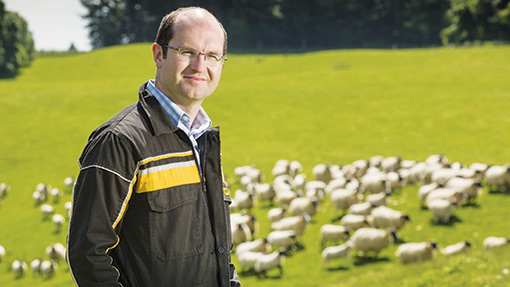EID tag system helps to bolster stock margins

An exacting approach is key to improved stock performance on a Scottish estate. Here, one of our 2013 Farm Manager of the Year finalists runs a complex sheep and beef operation.
Farm manager Sion Williams doesn’t rely on flashy equipment or groundbreaking theories to run the 3,786ha mixed farming business on the Bowhill Estate in the Scottish Borders.
Rather, his unwavering attention to detail helps him maximise every part of the enterprise.
The business employs 11 full-time workers across several farms to manage the 440 suckler cows, split into four herds, and 4,500 breeding ewes, split into seven flocks.
Mr Williams’ use of sheep tagging demonstrates his precise approach, which also leads to impressive results.
Farm facts
- 3,786ha mixed farming business on the Bowhill Estate
- 4,500 breeding ewes
- 440 suckler cows
- 11 staff
- Best hill flock recorded £5.05 a ewe profit from 2012 lamb crop, compared to £18.76 a ewe loss for industry top third, including family labour
- Cattle performed £32 a cow better than the QMS average including family labour
- Store lambs from the 2012 crop performed £1.50 a lamb better than the QMS average
In 2008, he became involved with the pilot scheme for the now-compulsory Scottish electronic identification (EID) tagging system.
About 700 of the lambs from the in-bye flock are tagged at birth and the rest are tagged at weaning, like the hill-flock lambs.
In Scotland, all lambs must be tagged by nine months and Mr Williams is turning this requirement to his advantage.
At weaning time, he batches lambs by weight so the best lambs go on the best pastures. A £700 stick reader is used to scan the tags whenever batches are moved.
He can trace the sires of those tagged at birth to make sure they are performing well. After breeding trials, the new breeds are finishing at 151 days, 32 days better than their traditional breed.
“Because we’ve got to tag them, we are making use of that tag to give us some information,” he says.
All lambs are sold through Dunbia to Sainsbury’s, with kill-sheet information for each animal.
Mr Williams pulls all this data into a spreadsheet. “We can trace to see how the breeds are doing and it takes us all the way through so we see what the performance is,” he says.
“I download the data and it goes into Farmplan software. It automatically registers and ties those batches together.
“When I come to sell them I create a batch to sell, so I know exactly what has gone off to the abattoir and how each lamb performs individually.”
Mr Williams also benchmarks the financial and physical performance of the animals looked after by each stockman and for the farm as a whole against statistics from Quality Meat Scotland.
“That gives us an idea how each enterprise is going on each farm,” he says. “We are either in the top third or between average and the top third. If we’re not in that, we are going wrong somewhere.”
The workers are involved in benchmarking, with the whole team meeting quarterly with Mr Williams to go through the finances.
“If you do not tell the workers where they stand financially, they have no comprehension of how much stuff costs. Then they start buying into the business.”
But Mr Williams also looks beyond his sectors. Through Scottish Enterprise he meets with a group of 17 farmers covering all farm types.
As well as “throwing ideas around”, members compare business performance, using measures such as full-time equivalents and percentages of output to cancel out differences in farm size.
The business also has a strong set of environmental credentials.
Sainsbury’s carries out a carbon footprint assessment of the enterprise each year and the farm was named the most improved in the supermarket’s lamb development group in 2013.
By growing his own grain for about £90/t and using it for feed, Mr Williams can cut both his costs and his carbon footprint.
Sion Williams’ cost-tracking tips
Cost of feed is the easiest place to start. When the roller goes on to the silage that is a cost going into the silage. Measure it through from the chopper to the silage sheet going on the clamp. That gives you a basis.
Variables are quite easy. I use cost centres with all of them. If I come to order wormer for a farm, it is set against that farm. It is the same for the vet and the vet and meds company.
Fixed costs are more difficult. QMS does that for me, on a percentage of turnover from each enterprise. You can’t ask the guys to fill in timesheets every 15 minutes.
Bowhill’s sheep and cattle enterprises are either in the top third or between average and top third results.

